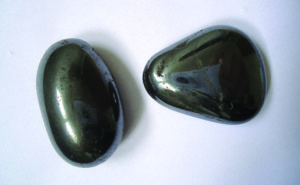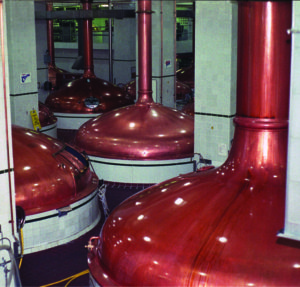Chapter 5. Chemical Composition
5.4 Determining Empirical and Molecular Formulas
Learning Objectives
By the end of this section, you will be able to:
- Determine the empirical formula of a compound
- Determine the molecular formula of a compound
In the previous section, we discussed how to calculate percent compositon from experimental mass measurements. Now we will see how to apply this to the determination of of the chemical formula of a compound.
Empirical Formulas
The empirical formula is the simplest formula of a compound. It is the smallest whole number ratio of atoms, but does not necessarily represent the arrangement of atoms in the actual molecule.
For example: a molecule of hydrogen peroxide is made up of two atoms of O and two atoms of H bonded together—the molecular formula is thus H2O2. Since the simplest ratio of H and O atoms is 1:1, the empirical formula (though not the actual arrangement of atoms within the molecule) is HO.
Example 1
Determine the empirical formula for dioxin (C12H4Cl4O2), a very powerful poison.
Solution
The subscripts are 12, 4, 4, and 2. These are all divisible by 2.
Thus, the empirical formula = C12/2H4/2Cl4/2O2/2= C6H2Cl2O
Test Yourself
Determine the empirical formula for the following compounds:
a) C6H16N2 b) CCl4 c) C4H10
Answers
a) C3H8N b) CCl4 c) C2H5
Determination of Empirical Formulas
As previously mentioned, the most common approach to determining a compound’s chemical formula is to first measure the masses of its constituent elements. However, we must keep in mind that chemical formulas represent the relative numbers, not masses, of atoms in the substance. Therefore, any experimentally derived data involving mass must be used to derive the corresponding numbers of atoms in the compound. To accomplish this, we can use molar masses to convert the mass of each element to a number of moles. We then consider the moles of each element relative to each other, converting these numbers into a whole-number ratio that can be used to derive the empirical formula of the substance. Consider a sample of compound determined to contain 1.71 g C and 0.287 g H. The corresponding numbers of atoms (in moles) are:
[latex]1.17 \;\text{g C} \times \frac{1 \;\text{mol C}}{12.011 \;\text{g C}} = 0.0\underline{974}11 \;\text{mol C with 3 sig figs}[/latex]
[latex]0.287 \;\text{g H} \times \frac{1 \;\text{mol H}}{1.00794 \;\text{g H}} = 0.\underline{284}74 \;\text{mol H with 3 sig figs}[/latex]
Thus, we can accurately represent this compound with the formula C0.974H0.284. Of course, per accepted convention, formulas contain whole-number subscripts, which can be achieved by dividing each subscript by the smaller subscript:
(Recall that subscripts of “1” are not written but rather assumed if no other number is present.)
The empirical formula for this compound is thus CH3. This may or may not be the compound’s molecular formula; however, we would need additional information to make that determination (as discussed later in this section).
Consider another example, a sample of compound determined to contain 5.31 g Cl and 8.40 g O. Following the same approach yields a tentative empirical formula of:
[latex]\text{Cl}_{0.150}\text{O}_{0.525} \; = \; \text{Cl}_{\frac{0.150}{0.150}} \; \text{O}_{\frac{0.525}{0.150}} = \text{ClO}_{3.5}[/latex]
In this case, dividing by the smallest subscript still leaves us with a decimal subscript in the empirical formula. To convert this into a whole number, we must multiply each of the subscripts by two, retaining the same atom ratio and yielding Cl2O7 as the final empirical formula.
In summary, empirical formulas are derived from experimentally measured element masses by:
- Deriving the number of moles of each element from its mass
- Dividing each element’s molar amount by the smallest molar amount to yield subscripts for a tentative empirical formula
- Multiplying all coefficients by an integer, if necessary, to ensure that the smallest whole-number ratio of subscripts is obtained
Note that it is important to follow the usual rule not to round-off values in the middle of a calculation. (Keep track of the significant figures after each step, but then use digits in your calculator beyond the last significant figure when you carry a value into a subsequent calculation.) In the end, you will round to whole numbers.
Figure 1 outlines this procedure in flow chart fashion for a substance containing elements A and X.

Example 2
A sample of the black mineral hematite (Figure 2), an oxide of iron found in many iron ores, contains 34.97 g of iron and 15.03 g of oxygen. What is the empirical formula of hematite?

Solution
For this problem, we are given the mass in grams of each element. Begin by finding the moles of each:
Next, derive the iron-to-oxygen molar ratio by dividing by the lesser number of moles:
The ratio is 1.000 mol of iron to 1.500 mol of oxygen (Fe1O1.5). Finally, multiply the ratio by two to get the smallest possible whole number subscripts while still maintaining the correct iron-to-oxygen ratio:
The empirical formula is Fe2O3.
Test Yourself
What is the empirical formula of a compound if a sample contains 0.130 g of nitrogen and 0.370 g of oxygen?
Answer
N2O5
It is helpful to remember some common fractions in decimal form so you can identify when you should multiply through:
1/2 = 0.500, therefore multiply by 2
1/3 = 0.333…, (x3) 1/4 = 0.25, (x4)
2/3 = 0.666…, (x3) 3/4 = 0.75, (x4)
Note: if you have a formula that has more than one of these decimals, you can do the multiplication stepwise:
For example: C1.50H1.33O1x 2 = C3H2.66O2x 3 = C9H8O6
Example 3
A 2.500 g sample of a compound containing only carbon and hydrogen is found to contain 2.002 g of carbon. Determine the empirical formula.
Solution
Step 1: We are told the compound contains 2.002 g of C. To find H, subtract the C from the total amount 2.500 g – 2.002 g = 0.498 g of H
Step 2: Convert each to mol:
[latex]2.002\; \text{g C} \times \frac{1\; \text{mol C}} {12.011\; \text{g C}} = 0.\underline{1666}8\; \text{mol C with 4 sig figs}[/latex]
[latex]0.498\; \text{g H} \times \frac{1\; \text{mol H}} {1.00794\; \text{g H}} = 0.\underline{494}1\; \text{mol H with 3 sig figs}[/latex]
Step 3: C0.16668/0.16668H0.4941/0.16668= C1.000H2.96 Because 2.96 is within a few hundredths of the whole number 3, we can round to C1H3. [Note: As long as the ratio value is < ± 0.2 of a whole number, it can be rounded.]
We have the empirical formula: CH3
Test Yourself
A sample of para-dichlorobenzene contains 11.314 g of carbon, 0.6330 g of hydrogen and 11.132 g of chlorine. What is the empirical formula of this compound?
Answer
C3H2Cl

For additional worked examples illustrating the derivation of empirical formulas, watch the brief video clip.
Deriving Empirical Formulas from Percent Composition
Finally, with regard to deriving empirical formulas, consider instances in which a compound’s percent composition is available rather than the absolute masses of the compound’s constituent elements. In such cases, the percent composition can be used to calculate the masses of elements present in any convenient mass of compound; these masses can then be used to derive the empirical formula in the usual fashion.
Example 4
The bacterial fermentation of grain to produce ethanol forms a gas with a percent composition of 27.29% C and 72.71% O (Figure 3). What is the empirical formula for this gas?

Solution
Since the scale for percentages is 100, it is most convenient to calculate the mass of elements present in a sample weighing 100 g. The calculation is “most convenient” because, per the definition for percent composition, the mass of a given element in grams is numerically equivalent to the element’s mass percentage. This numerical equivalence results from the definition of the “percentage” unit, whose name is derived from the Latin phrase per centum meaning “by the hundred.” Considering this definition, the mass percentages provided may be more conveniently expressed as fractions:
The molar amounts of carbon and hydrogen in a 100-g sample are calculated by dividing each element’s mass by its molar mass:
Coefficients for the tentative empirical formula are derived by dividing each molar amount by the lesser of the two:
Since the resulting ratio is one carbon to two oxygen atoms, the empirical formula is CO2.
Test Yourself
What is the empirical formula of a compound containing 40.0% C, 6.71% H, and 53.28% O?
Answer
CH2O
Example 5
An iron oxide contains 69.9% Fe by mass. Find its empirical formula. Note: “oxide” means it contains oxygen, as well as iron.
Solution
Step 1: If we assume 100 g sample, it must contain 69.9 g of Fe and thus 100-69.9 = 30.1 g of O.
Step 2: Convert each to mol:
[latex]69.9\; \text{g Fe} \times \frac{1\; \text{mol Fe}} {55.847\; \text{g Fe}} = \underline{1.25}16\; \text{mol Fe with 3 sig figs}[/latex]
[latex]30.1\; \text{g O} \times \frac{1\; \text{mol O}} {15.9994\; \text{g O}} = \underline{1.88}13\; \text{mol O with 3 sig figs}[/latex]
Step 3: 1.2516… is the smallest number, so we will divide each subscript by that value:
Fe1.2516O1.8813= Fe1.2516/1.2516 O1.8813/1.2516 = Fe1.0000O1.503
Step 4: Since the ratio for oxygen is 1.503 and does not fall into the acceptable limit where we can round off [Note: As long as the ratio value is < ± 0.2 of a whole number, it can be rounded.], we cannot interpret 1.503 as a whole number (i.e. NOT 1 or 2!). We recognize that 1.503 is approximately 1.50, so we can multiply each subscript by 2 to get a whole numbers: Fe1×2O1.5×2= Fe2O3.
The empirical formula is Fe2O3
Test Yourself
Nylon-6 contains 63.68% C, 12.38% N and 9.80% H and 14.14% O by mass. What is the empirical formula for Nylon-6?
Answer
C6H11NO
Derivation of Molecular Formulas
Recall that empirical formulas are symbols representing the relative numbers of a compound’s elements. Determining the absolute numbers of atoms that compose a single molecule of a covalent compound requires knowledge of both its empirical formula and its molecular mass or molar mass. These quantities may be determined experimentally by various measurement techniques. Molecular mass, for example, is often derived from the mass spectrum of the compound (see discussion of this technique in the previous chapter on atoms and molecules). Molar mass can be measured by a number of experimental methods, many of which will be introduced in later chapters of this text.
Molecular formulas are derived by comparing the compound’s molecular or molar mass to its empirical formula mass. As the name suggests, an empirical formula mass is the sum of the average atomic masses of all the atoms represented in an empirical formula. If we know the molecular (or molar) mass of the substance, we can divide this by the empirical formula mass in order to identify the number of empirical formula units per molecule, which we designate as n:
The molecular formula is then obtained by multiplying each subscript in the empirical formula by n, as shown by the generic empirical formula AxBy:
For example, consider a covalent compound whose empirical formula is determined to be CH2O. The empirical formula mass for this compound is approximately 30 amu (the sum of 12 amu for one C atom, 2 amu for two H atoms, and 16 amu for one O atom). If the compound’s molecular mass is determined to be 180 amu, this indicates that molecules of this compound contain six times the number of atoms represented in the empirical formula:
Molecules of this compound are then represented by molecular formulas whose subscripts are six times greater than those in the empirical formula:
Note that this same approach may be used with the molar mass (g/mol) instead of the molecular mass (amu).
Example 6
Nicotine, an alkaloid in the nightshade family of plants that is mainly responsible for the addictive nature of cigarettes, contains 74.02% C, 8.710% H, and 17.27% N. If 40.57 g of nicotine contains 0.2500 mol nicotine, what is the molecular formula?
Solution
Determining the molecular formula from the provided data will require comparison of the compound’s empirical formula mass to its molar mass. As the first step, use the percent composition to derive the compound’s empirical formula. Assuming a convenient, a 100-g sample of nicotine yields the following molar amounts of its elements:
Next, we calculate the molar ratios of these elements relative to the least abundant element, N.
The C-to-N and H-to-N molar ratios are adequately close to whole numbers, and so the empirical formula is C5H7N. The empirical formula mass for this compound is therefore 81.117 amu/formula unit, or 81.117 g/mol formula unit.
We calculate the molar mass for nicotine from the given mass and molar amount of compound:
Comparing the molar mass and empirical formula mass indicates that each nicotine molecule contains two formula units:
Thus, we can derive the molecular formula for nicotine from the empirical formula by multiplying each subscript by two:
Test Yourself
What is the molecular formula of a compound with a percent composition of 49.47% C, 5.201% H, 28.84% N, and 16.48% O, and a molecular mass of 194.2 amu?
Answer
C8H10N4O2
Example 7
A 13.8 g sample of a compound containing only nitrogen and oxygen produced 4.2 g of nitrogen upon decomposition. What is its empirical formula and molecular formula if the molar mass is 90.3 g/mol?
Solution
First, we need to determine the empirical formula:
Step 1: We are told it contains 4.2 g of N. Thus it must contain 13.8 g – 4.2 g = 9.6 g of O.
Step 2: Convert each to mol:
[latex]4.3\; \text{g N} \times \frac{1\; \text{mol N}} {14.0067\; \text{g N}} = 0.\underline{30}7\; \text{mol N with 2 sig figs}[/latex]
[latex]9.5\; \text{g O} \times \frac{1\; \text{mol O}} {15.9994\; \text{g O}} = 0.\underline{59}4\; \text{mol O with 2 sig figs}[/latex]
Step 3: N0.307/0.307O0.594/0.307= N1.00O1.93
Step 4: The value 1.93 (calc. to 2 sig fig’s) is close enough to round to the whole number, or NO2
Then, we need to use the molar mass values to determine the molecular formula:
Step 1:
Empirical formula molar mass = 14.0067 g/mol + 2(15.9994 g/mol) = 46.0055 g/mol
Step 2:
Molar mass of molecular formula / Molar mass empirical formula = 90.3 g/mol / 46.0055 g/mol = 1.963 (to 3 SF) = 2
Step 3: N1×2O2×2= N2O4
Test Yourself
Caffeine contains hydrogen, carbon, nitrogen and oxygen. The mass % composition is as follows: C = 49.47%; H = 5.191%; N = 28.86%; O = 16.48 %. The molar mass is approximately 194 g/mol. Determine the molecular formula.
Answer
C8H10N4O2
Key Concepts and Summary
The chemical identity of a substance is defined by the types and relative numbers of atoms composing its fundamental entities (molecules in the case of covalent compounds, ions in the case of ionic compounds). A compound’s percent composition provides the mass percentage of each element in the compound, and it is often experimentally determined and used to derive the compound’s empirical formula. The empirical formula mass of a covalent compound may be compared to the compound’s molecular or molar mass to derive a molecular formula.
Determining an Empirical Formula
STEP 1: Determine the mass of each element in a particular sample. If you are given the data in percent composition, it’s easiest to assume a total sample size of 100g. (If the percent of one element is 64%, 100 g of the compound would contain 64 g of that particular element.)
STEP 2: For each element, change from g [latex]\longrightarrow[/latex] mol. These mole values become first-try subscripts for the formula—for example, C0.1H0.4O0.1
STEP 3: Now divide each element’s subscript by the lowest subscript value.
E.g.: C0.1H0.4O0.1, divide each subscript by 0.1 and get CH4O
STEP 4: If any subscript is NOT a whole number (or easily rounded to one), then multiply ALL subscripts by the smallest integer that will turn all subscripts to whole integers. This is now the empirical formula. E.g.: C1.5N0.5H4 multiply each by 2 and get C3NH8
Determining the Molecular Formula from the Empirical Formula
STEP 1: Calculate the molar mass of the empirical formula.
STEP 2: Divide the given molecular molar mass by the molar mass calculated for the empirical formula.
STEP 3: Multiply each subscript by the whole number that resulted from step 2. This is now the molecular formula.
Key Equations
- [latex]\%\text{X} = \frac{\text{mass X}}{\text{mass commpound}} \times 100\%[/latex]
- [latex]\frac{\text{molecular or molar mass ( amu or} \;\frac{\text{g}}{\text{mol}})}{\text{empirical formula mass ( amu or} \;\frac{\text{g}}{\text{mol}})} = n \;\text{formula units/molecule}[/latex]
- (AxBy)n = AnxBny
Exercises
1. Determine the empirical formulas for compounds with the following percent compositions:
a) 15.8% carbon and 84.2% sulfur
b) 40.0% carbon, 6.7% hydrogen, and 53.3% oxygen
2. A compound of carbon and hydrogen contains 92.3% C and has a molar mass of 78.1 g/mol. What is its molecular formula?
3. Determine the empirical and molecular formula for chrysotile asbestos. Chrysotile has the following percent composition: 28.03% Mg, 21.60% Si, 1.16% H, and 49.21% O. The molar mass for chrysotile is 520.8 g/mol.
4. A major textile dye manufacturer developed a new yellow dye. The dye has a percent composition of 75.95% C, 17.72% N, and 6.33% H by mass with a molar mass of about 240 g/mol. Determine the molecular formula of the dye.
Answers
1. a) CS2 b) CH2O
2. C6H6
3. Mg3Si2H3O8 (empirical formula), Mg6Si4H6O16 (molecular formula)
4. C15H15N3
Glossary
empirical formula: is the simplest formula of a compound. It is the smallest whole number ratio of atoms, but does not necessarily represent the arrangement of atoms in the actual molecule.
empirical formula mass: sum of average atomic masses for all atoms represented in an empirical formula
percent composition: percentage by mass of the various elements in a compound

